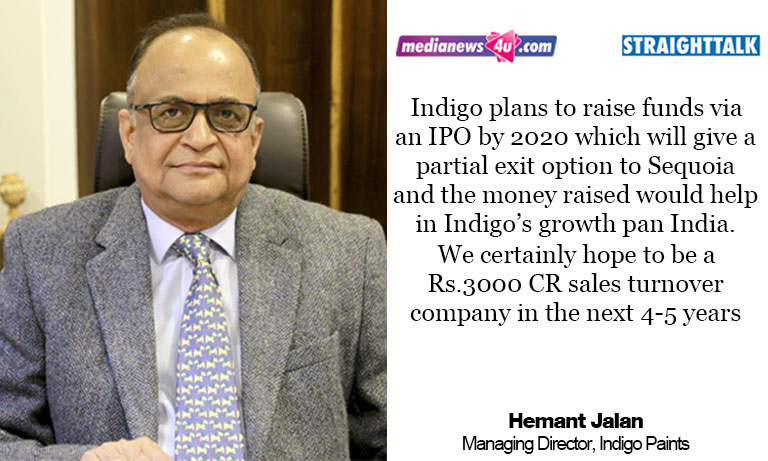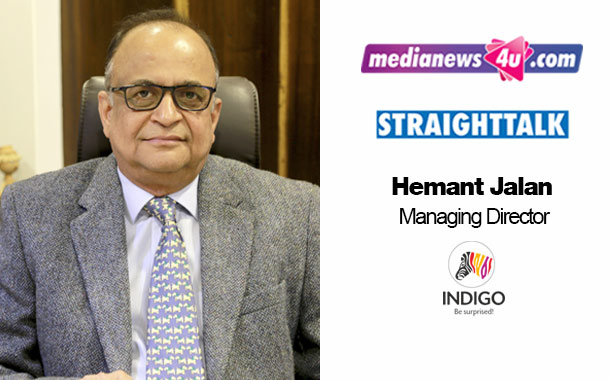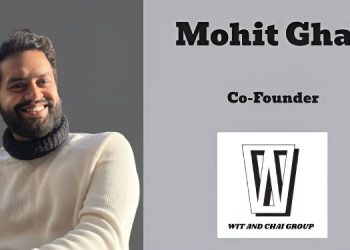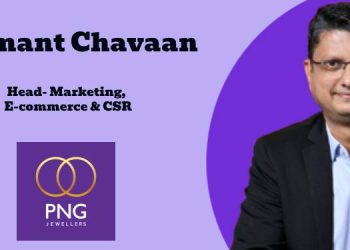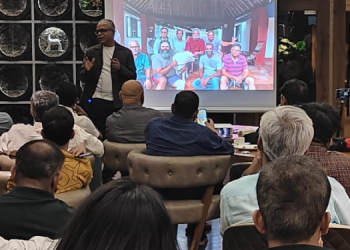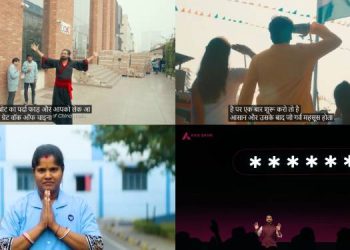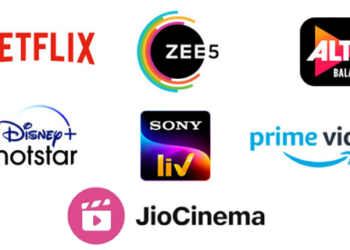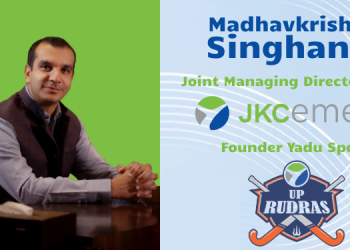In the year 2000, Indigo Paints started out with the manufacture of lower-end cement paints, gradually expanded to cover most segments of water-based paints like Exterior Emulsions, Interior Emulsions, Distempers, and Primers etc.
Today a national brand, Indigo Paints stands out as one of the strongest contenders in the Indian paint industry, being rated as an innovative paint manufacturer, which keeps coming out with unique products.
In this Straight Talk, Hemant Jalan, Managing Director, Indigo Paints has opened up Indigo Paint’s strategy behind the revamp, getting MSD as the brand ambassador, their media mix and the way forward.
Edited Excerpts.
How is the paint manufacturing industry fairing after the post Demonetization and GST? Where does Indigo Paints stand in it?
There was a temporary setback for about 30-45 days post Demonetization, since end-customers usually purchase paints on cash from the retail outlets. However, very soon the paint retailers installed POS machines, or started accepting cheques; hence there was no long-term impact of Demonetization on the paint industry.
As for GST, I feel that the rollout was quite smooth, and I am not aware of any paint manufacturer who was negatively impacted by it. There was a temporary lull in offtake one month before GST rollout, but that was quickly made up post-GST.
In fact the GST rollout has helped the organized sector players like us, since the “unorganized” sector has suffered a blow, and has either shut-down or party migrated to the formal economy. So GST has helped organized players who were honest taxpayers earlier also.
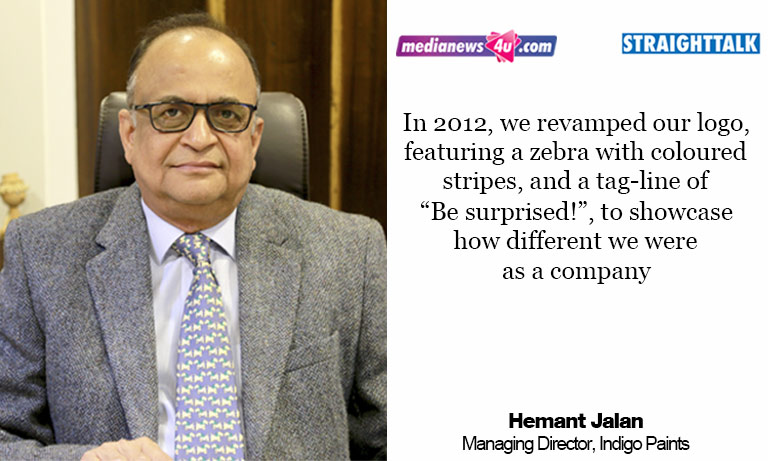
Could you share the journey of the Brand Indigo and strategy behind the revamp with new logo and identity?
The first 10 years of Indigo Paints were a fight for survival, as we were competing against very large players, with well entrenched brand image. However, during this struggle phase, we focused on producing innovative products, which were hitherto not manufactured by anyone else, e.g. Metallic paints, Ceiling paints, Roof tile paints, Floor paints etc. This helped us expand our distribution reach, as most retailers wanted to stock our unique paint products, made popular by word-of-mouth publicity. We also relied heavily on motivating our sales force with very high variable pay, linked to achievement of stiff growth targets.
In 2012, we revamped our logo, featuring a zebra with coloured stripes, and a tag-line of “Be surprised!” to showcase how different we were as a company. A modest start was made towards consumer advertising, which has gathered considerable momentum over the last 8 years. Today, Indigo is a well recognized brand in every corner of India, and the company has a strong footprint in 27 States of the country. The company has maintained a CAGR of over 40% for the last 10 years in a row, and hopes to continue this growth rate for many more years.

What made you to zero down on MS Dhoni as your brand ambassador, how has this partnership added the value to your brand?
In a country as diverse as India, where a pan-India seller like us needs to advertise in 9 different languages in different parts of the country, selecting a brand ambassador is not an easy task. It is very difficult to find a celebrity who has pan-Indian appeal. Bollywood stars are great in North India, but ineffective in southern regions, which have their own regional celluloid superstars.
Cricket is the only “religion” which binds the entire country. MS Dhoni was an excellent fit, because his innovative cricketing style matched our innovative approach in paints. Also, his small-town humble origins to international fame sort of mirrored our own journey. He was an obvious choice, as he connects with consumers in every corner of India, across age groups and genders. His addition has been wonderful for our brand, and we have been pleasantly surprised to see the connect that people feel across India with MSD. He is not just a great cricketer, but admired for his calm persona, and non-assuming demeanor. We could not have asked for anything better.
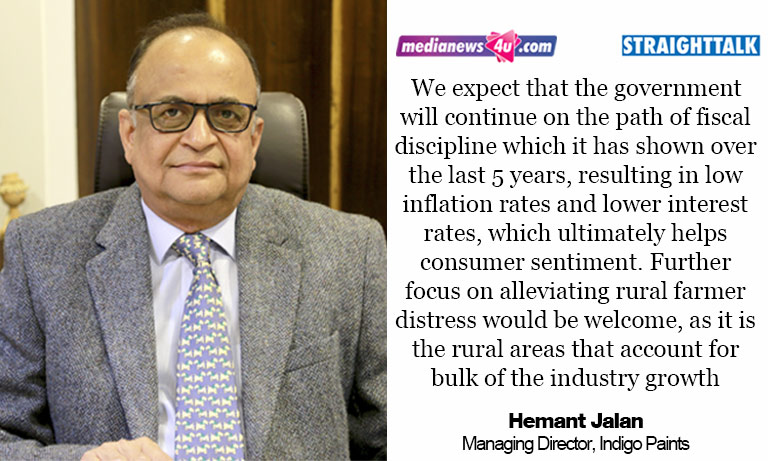
What is your choice of Media mix in advertising, which is your primary media vehicle and why?
Over the last 5-6 years, we have been spending roughly 8-9% of annual sales on media advertising. The advertising happens mainly on Television, with some support from print and outdoor hoardings. Paint is a visual product, and needs to be conveyed by visual means of storytelling. It is a mass consumption item for people, from lower middle class background all the way to the uber rich, and Television is the obvious choice for mass outreach. However, given the geographical diversity of the country, our Television advertising is by no means restricted to the National Hindi channels, but involves considerable spend on Regional TV channels in Malayalam, Tamil, Telugu, Kannada, Marathi, Oriya, Bengali, Assamese and Bhojpuri.
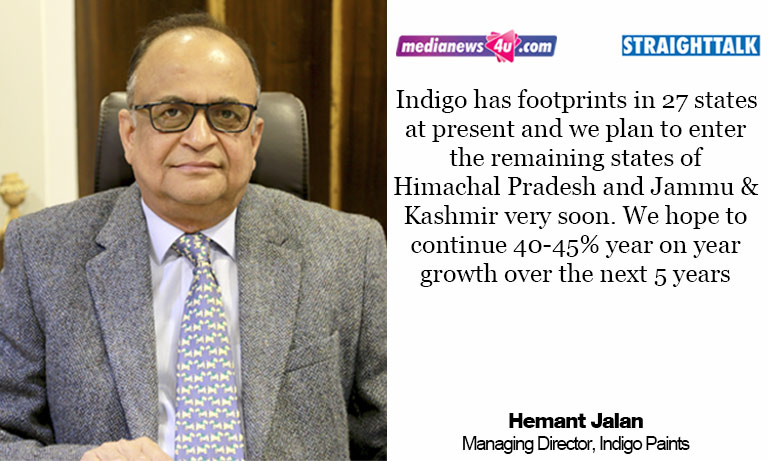
Indian Paint Industry is buzzing with refreshing product line-up with more importance for eco-friendly approach, Could you brief us on Indigo’s innovation plans?
There has been a lot of hype in media over eco-friendly products, but we feel that India is not fully ready for it. Of course, paint consumption in India has gradually shifted over the years from solvent-based paints to much more eco-friendly water-based paints. However, various attempts by major players to introduce paints which are specifically eco-friendly to an extreme degree, have met with very lukewarm responses in the market. Product innovation is a must for any industry, and something that Indigo Paints thrives on, but I do not see the “eco-friendly paint” as a direction for short-term innovation. Our innovation is focused on unearthing new application areas for paints, and tailor-making products for such end-use.
What is your expectation from the new government for paint industry? Will the slowdown in Automobile industry impact Paints industry too?
The Automotive industry slowdown will definitely impact paint manufacturers who service that sector. Since we do not manufacture automotive paints, we are unaffected. In decorative paints, roughly 80% of paint consumption is for re-painting, and hence new construction is not a major factor in paint consumption. We expect and hope that the government will continue on the path of fiscal discipline which it has shown over the last 5 years, resulting in low inflation rates and lower interest rates, which ultimately helps consumer sentiment. Further focus on alleviating rural farmer distress would be welcome, as it is the rural areas that account for bulk of the industry growth. Otherwise, I do not think we look upon government sops for growth.
What are the future plans of Indigo Paints?
Indigo has footprints in 27 states at present and we plan to enter the remaining states of Himachal Pradesh and Jammu & Kashmir very soon.We hope to continue 40-45% year on year growth over the next 5 years. We also plan to raise funds via IPO by 2020 which will give a partial exit option to Sequoia and the money raised would help in Indigo’s growth pan India. We certainly hope to be an Rs.3000 CR sales turnover company in the next 4-5 years.
